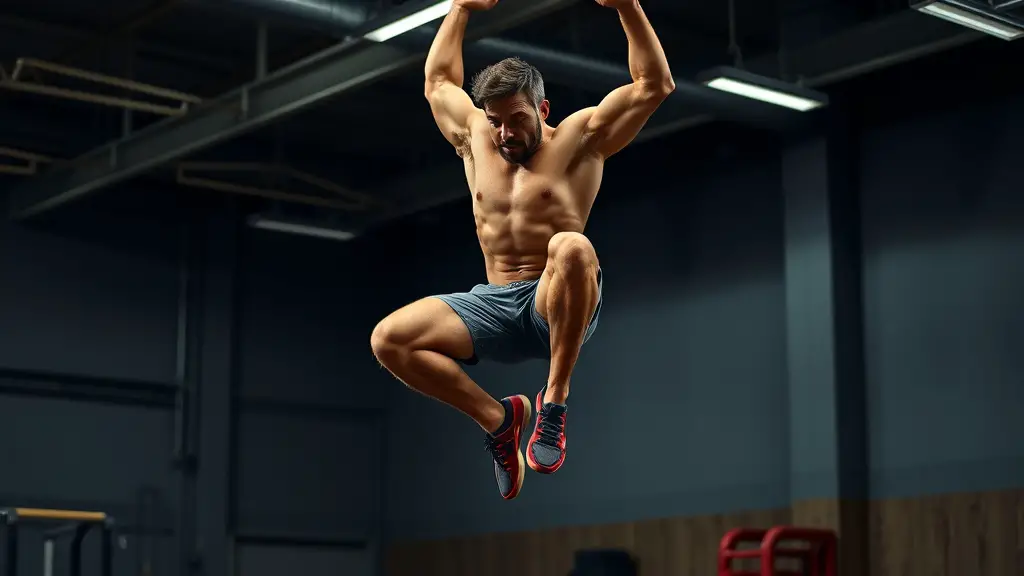The Best Workouts to Develop a Strong Vertical Jump

To develop a strong vertical jump, you need a thorough approach. Focus on strength training with squats and lunges to build powerful leg muscles. Incorporate plyometric workouts like box jumps and depth jumps for explosiveness. Don’t overlook flexibility routines to improve range of motion and reduce injury risk. Finally, practice proper jumping techniques and landing drills to enhance your form. Keep pushing your limits, and you’ll discover even more effective strategies to boost your vertical jump.
Understanding the Mechanics of a Vertical Jump

Understanding the mechanics of a vertical jump is essential if you want to maximize your performance and increase your height. It all starts with jump biomechanics, which involves how your body moves and interacts with the ground. Your legs, core, and arms play vital roles in generating force efficiently.
When you prepare to jump, you’re not just relying on your leg strength; you’re also harnessing the power of your entire body. A proper loading phase, where you bend your knees and lower your center of gravity, sets you up for explosive force generation. As you shift to your jump, engage your core to stabilize your body, ensuring that all your energy is directed upward.
Essential Strength Training Exercises
To maximize your vertical jump, incorporating strength training exercises into your routine is key. Focus on compound movements like squats and deadlifts, which build the powerful muscles in your legs. These exercises not only enhance strength but also improve your core stability, an essential component for an explosive jump.
Add lunges and step-ups to target your glutes and hamstrings, ensuring all muscle groups work in harmony. Don’t overlook your upper body; exercises like bench presses and rows enhance overall body strength, contributing to your jumping ability.
Incorporate lunges and step-ups to strengthen glutes and hamstrings, while upper body exercises boost overall jumping power.
Incorporate core exercises such as planks and Russian twists to fortify your midsection. A strong core stabilizes your body during takeoff, increasing your jump height. Additionally, consider incorporating alternative exercises to pistol squats to further enhance your leg strength and balance.
Stay consistent and progressively increase weights to challenge your muscles. Remember, strength training isn’t just about lifting; it’s about building a foundation that supports your vertical leap.
Plyometric Workouts for Explosiveness

While strength training lays the groundwork for your vertical jump, plyometric workouts are essential for developing the explosiveness required to elevate your performance. These workouts focus on explosive movements that enhance your jumping techniques, allowing you to spring off the ground with power and agility.
Start with box jumps, which train your muscles to engage rapidly, improving your reaction time. Incorporate depth jumps to refine your ability to absorb and convert energy into upward force.
Don’t overlook plyometric push-ups; they build upper body explosiveness that translates into better overall body coordination during jumps.
Aim for 2-3 plyometric sessions per week, mixing varying heights and intensities to challenge your body. As you progress, you’ll notice significant improvements in your vertical leap, making those high-flying dunks and jump shots feel effortless. Stay committed, push your limits, and watch your explosiveness soar!
Flexibility and Mobility Routines
After honing your explosiveness through plyometric workouts, it’s important to focus on flexibility and mobility routines that complement your training. Incorporating dynamic stretching into your warm-up can greatly enhance your range of motion and prepare your muscles for action. Aim for movements like leg swings and arm circles to activate your joints and increase blood flow.
Don’t overlook joint mobility exercises, as they’re essential for maintaining healthy movement patterns. Incorporate ankle circles, hip openers, and shoulder dislocates to make certain your joints are flexible and ready for explosive movements.
Adding these routines to your regimen will not only improve your vertical jump performance but also help in injury prevention. Consistency is key; dedicate time to these practices regularly, and you’ll notice a marked improvement in both your flexibility and your ability to jump higher. Stay committed to your training, and success will follow!
Incorporating Technique and Form Drills

Incorporating technique and form drills is essential for maximizing your vertical jump, as proper mechanics can greatly enhance your performance and reduce the risk of injury. Focus on mastering jumping techniques, such as the two-foot take-off and single-leg jumps, to build a solid foundation. Always emphasize proper landing to absorb impact effectively. Consistent training with different exercises, including plyometric exercises, will yield the best improvement in your vertical jump.
Here’s a table to help you structure your drills:
| Drill Type | Focus Area | Key Points |
|---|---|---|
| Two-Foot Take-Off | Jumping Technique | Engage core, explosive power |
| Single-Leg Jump | Balance & Strength | Control landing, maintain form |
| Box Jumps | Plyometric Power | Land softly, full extension |
Integrating these drills into your routine will not only increase your vertical but also fine-tune your overall athleticism. Stay consistent, and you’ll see significant improvements!
Frequently Asked Questions
How Long Does It Take to See Improvement in My Vertical Jump?
When you start jump training, you might wonder about the improvement timeline. Typically, you’ll see noticeable gains in your vertical jump within 4 to 6 weeks, but this can vary based on your commitment and consistency. Focus on proper techniques and include strength and plyometric exercises in your routine. Stay dedicated, track your progress, and remember, every effort counts. With persistence, you’ll be leaping higher than ever before!
Can Nutrition Impact My Vertical Jump Performance?
Can what you eat really make a difference in your vertical jump? Absolutely! Nutrition plays a vital role in your performance. Focus on nutrient timing; consuming the right foods before and after workouts can maximize your gains. Prioritize your protein intake to support muscle repair and growth. By fueling your body with the right nutrients, you’re not just enhancing recovery, you’re setting yourself up for bigger jumps and better results.
What Role Does Body Weight Play in Jumping Ability?
Bodyweight plays an essential role in your jumping ability. Lighter athletes often find it easier to achieve ideal jump mechanics, as they can generate more explosive power relative to their weight. Incorporating bodyweight exercises, like squats and lunges, can enhance your strength and coordination, leading to better jumps. Focus on mastering these movements to improve your overall performance. Remember, a solid foundation in body weight will support your vertical leap goals!
Are There Any Common Injuries Associated With Vertical Jump Training?
Absolutely, there are common jumping injuries associated with vertical jump training, such as ankle sprains and knee issues. To minimize risks, it’s vital you take proper training precautions. Always warm up thoroughly, use correct form, and gradually increase intensity. Strengthening supporting muscles can also help. Remember, listening to your body is key; if something feels off, don’t push through the pain. Staying injury-free is essential for achieving your jumping goals!
How Often Should I Train for Optimal Vertical Jump Gains?
Research shows that athletes who train their vertical jump two to three times a week see significant improvements. For ideal gains, focus on frequency training while ensuring you incorporate recovery periods. Your muscles need time to rebuild stronger after intense workouts. Balance your sessions with plyometrics and strength training, and don’t underestimate the power of rest days. Consistency and smart recovery will elevate your performance and help you reach your vertical jump goals.





